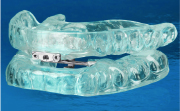Sleep Apnea Dental Appliances
A growing treatment for the sleeping disorder known as sleep apnea is Oral Appliance Therapy. Prescribed by a dentist specializing in sleep disorders, this treatment has been used for years as a successful treatment for some forms of sleep apnea.

In recent years, oral appliance therapy has grown dramatically in popularity, particularly in the United States, and is seen as a welcome alternative to the positive airway pressure, or PAP treatment. The Oral Appliance Therapy treatment involves the use of a sleep apnea dental appliance prescribed by the dentist, usually in the form of a specialized mouthpiece. This sleep apnea dental appliance is an easy to use, comfortable device that works painlessly while you sleep.
The mouthpiece is simply inserted before the patient lies down to go to sleep and it can help to reduce, or sometimes even prevent, the pauses in breathing that is caused by sleep apnea. It is most commonly used for obstructive sleep apnea. Obstructive sleep apnea (OSA) is caused by the relaxation of the muscles involved in the breathing process during the hours of sleep. This relaxation leads to the narrowing of the airways, and eventually it causes the lapses in breathing that are typically associated with sleep apnea. A sleep apnea dental appliance works by shifting the lower jaw during sleep and holding it in place. Adjusting the jaw with this sleep apnea dental appliance keeps the airway open during the times of sleep. By doing this, it helps offset the potential of lapsed breathing when the muscles relax. The airway will be kept open and normal breathing can be maintained throughout the night.
Is a sleep apnea dental appliance right for you?
Sleep apnea dental appliances are generally only used for obstructive sleep apnea, and generally only when it is caused due to obstructive sleep apnea. Other forms of sleep apnea and more serious sleep apnea generally will not be positively affected by the use of the mouthpiece device. In these situations, other treatment options are prescribed, such as certain medications or the use of the continuous positive airway pressure (CPAP) device.
The sleep apnea dental appliance mouthpiece is a preferred alternative to the standard positive airway pressure device generally used in the past for many individuals. The CPAP device involves the use of pressurized air tanks and the use of face or nose masks, which can be seen as obtrusive and awkward to wear.
If the sleep specialist determines an oral appliance is appropriate for your obstructive sleep apnea the simple mouthpiece design is a welcome alternative to help with symptoms of sleep apnea while maintaining its low profile. Be sure to contact Dr. Jennifer Le about the sleep apnea dental appliances that are available. The oral appliance, if recommended, can be a cost effective and welcome simple device alternative to the traditional methods to help return you to a healthy, restful, safe sleep patterns.
Since October 15, 2013, Dr. Le is in-network with Blue Cross Blue Shield, Cigna and Choice Provider for VA medical insurance and as of September 17, 2014, in-network with Medicare to provide the sleep apnea appliance as a covered medical service.
Dental appliances we recommend
We use different oral appliances in our office. The choice of which appliance will be used for each patient is based on many factors including severity of the apnea condition, patient's bite and jaw structure, size of the tongue and soft palate, presence of tooth clenching or grinding, jaw range of motion, health of teeth and gums, and many others. We use our expertise to help guide the patient to using the appliance that will be most comfortable and effective for that individual's situation. Many different appliances have been developed over the past several years, but currently we use:

This is an oral appliance, which fits over the upper and lower teeth, much like a sports mouthguard. Unlike a sports mouthguard, however, it is a precision-made, clinically-tested medical device, which is highly effective (in most cases) in preventing snoring and obstructive sleep apnea. The medical term for your lower jaw is 'mandible' and an oral appliance worn over the teeth is a 'splint'.

This is an oral appliance, which fits over the upper and lower teeth, much like a sports mouthguard. Unlike a sports mouthguard, however, it is a precision-made, clinically-tested medical device, which is highly effective (in most cases) in preventing snoring and obstructive sleep apnea. The medical term for your lower jaw is 'mandible' and an oral appliance worn over the teeth is a 'splint'.

A fully-adjustable oral appliance used for the treatment or snoring and Obstructive Sleep Apnea. Fabricated of thermoactive acrylic, becomes pliable for easy insertion and confirms securely to the dentition for an excellent fit while significantly decreasing soft tissue and tooth discomfort. Small increments of forward lower jaw advancement are initiated by the patient under the direction of a dentist and this helps avoid rapid jaw movements that can cause significant patient discomfort. Once warmed under hot water and inserted, the acrylic resin hardens as it cools to body temperature and firmly affixes itself to both arches. Lateral and vertical jaw movement is permitted which enables the patent to yawn, swallow, and drink water without dislodging the appliance.

A hard plastic appliance which has the adjustment hardware set on the cheek side of the molar teeth. It prevents side-to-side motion, but since the bottom jaw is held closed with small orthodontic rubber bands, opening the jaws is fairly easy. The modified Herbst is smaller than most appliances and has a long life span. It allows jaw movement in all directions but backwards. The patient can take medications, use an asthma inhaler or talk with this appliance in place. This appliance can be fabricated out of material that has no methylmethacrylate and is thus safe for patients who are allergic to this material.The modified Herbst is one of the 'yardsticks' used by other appliances seeking FDA acceptance. Patients who severely grind their teeth at night can crack this appliance

The thinnest and least bulky of all the appliances. It is similar to clear acrylic orthodontic retainers, and the 'hardware' (located to the cheek side of the molar teeth) consists of specially designed, patented elastic bands. This appliance moves the jaw forward in fairly significant steps, which may be difficult to tolerate. Some care must be taken to avoid breaking the lower portion when replacing the custom elastics. This is well tolerated by patients who grind their teeth. It has no metal and can be used by patients with a nickel metal allergy.

This device consists of an upper and lower tray that fit over the teeth. Fitting more comfortably in the mouth than the original,this and the Elite feature smaller hardware that provides more room for the tongue and allows the lips to close. On the this one, a hook mechanism attached to the upper tray fits into a socket attached to the lower tray and positions the lower jaw forward. Allowing for a greater range of lateral movement, the Elite features a simple hook mechanism attached to the upper tray that slides under a bar attached to the lower tray. Three hook sizes offer increased range of adjustment. An adjustment key enables the patient to adjust the protrusion of the lower jaw while wearing the device until a comfortable and effective position is achieved.

